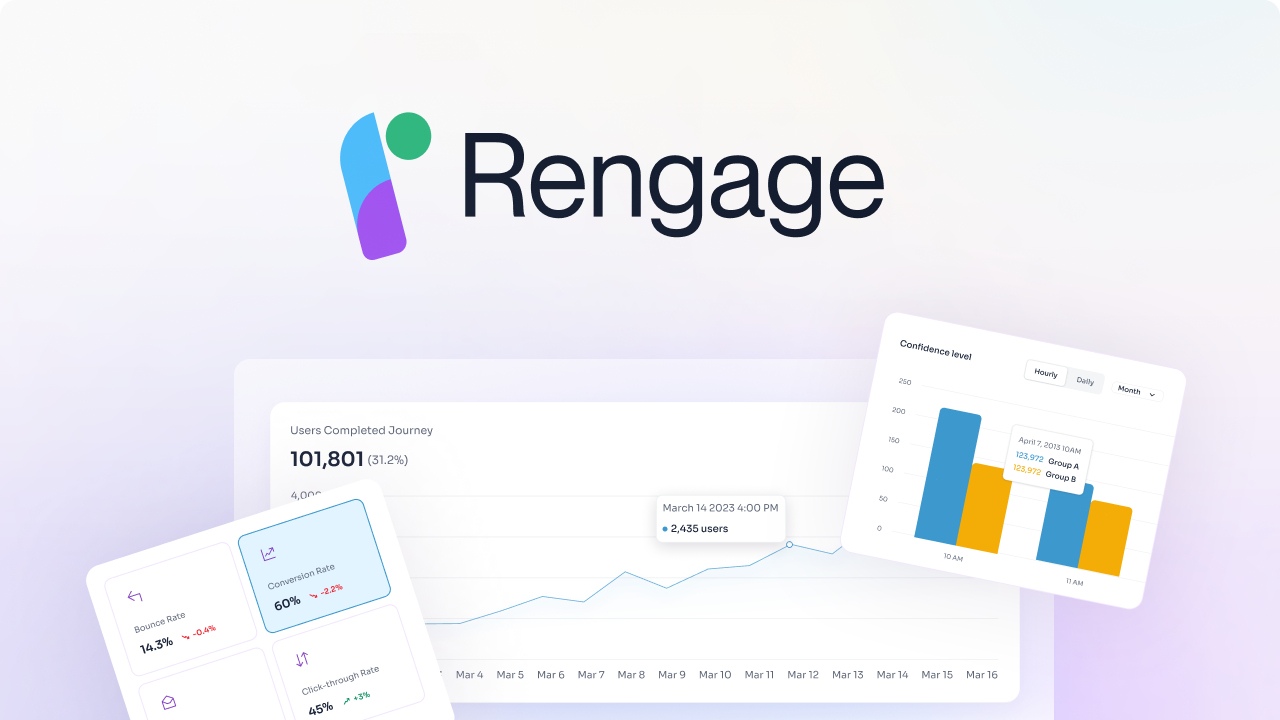Managing the customer journey can be quite the puzzle! Companies have to navigate through various stages in the customer lifecycle to ensure that their client relationships bloom. Mastering customer journey management and customer lifecycle management can give you more insights into the things you do and even open up different revenue streams. Learn how to develop strategies that help you win and retain customers, as you track and analyze customer data to make better business decisions. Dive deep into customer journey management to uncover the secrets to long-term customer satisfaction. Just one click reveals the guiding principles that lead to customer loyalty.
What Is Customer Journey Management?

Customer journey management is the art of being able to understand, map, design, and improve the interactions and processes that make up the entire customer experience. It doesn’t matter if a customer is actively researching your products, passively encountering a social media post, browsing in a physical store, or contacting customer support – whatever the interaction, it’s happening as part of an overall journey. Managing that journey really just means making those isolated moments better, but also ensuring that they’re interconnected and aligned.
The Role of Customer Journey Management in Customer Relationships
The purpose of customer journey management is ultimately to fine-tune the customer experience until it’s as seamless as possible, that the path towards purchase is frictionless, and that each touchpoint works as part of a broader CX strategy. Customer expectations are higher than ever, and people are much more careful with where they spend their hard-earned money. So it’s vital to be able to offer them journeys that offer zero resistance. In that sense, customer journey management needs full company buy-in. It’s top-down, as well as bottom-up – where customer journey data informs both individual channels as well as your overarching business strategy.
5 Main Benefits of Customer Journey Management

1. Improved Customer Satisfaction
I have observed that customer journey management ensures that each customer interaction with a business leaves them satisfied. By listening to customer feedback and understanding needs, businesses can tailor their offerings to exceed expectations. This attention to detail meets customer needs and makes them feel valued and understood, leading to long-lasting satisfaction and positive experiences.
2. Increased Customer Loyalty
Consistently delivering exceptional experiences throughout the customer journey fosters strong bonds of loyalty. Customers who feel valued and appreciated at every touchpoint are likelier to stay loyal to a brand. Customer journey management focuses on building trust and reliability, ensuring that customers continue to choose a business over competitors.
3. Enhanced Brand Reputation
By prioritizing customer satisfaction and loyalty, businesses enhance their brand reputation. Satisfied customers are likelier to share positive experiences with others, leading to word-of-mouth recommendations and a positive brand image. Through customer journey management, businesses can cultivate a reputation for reliability and exceptional service, further strengthening their position in the market.
4. Higher Conversion Rates
Optimizing the customer journey through digital journey management can significantly impact conversion rates. By understanding customer behaviors and preferences, businesses can tailor their marketing efforts and product offerings to resonate with their target audience. This personalized approach increases the likelihood of converting prospects into customers, driving revenue growth and business success.
5. Data-Driven Decision-Making
Customer journey management relies on data to inform decision-making processes. Businesses gain valuable insights into customer behavior and preferences by collecting and analyzing data at every touchpoint. This data-driven approach allows companies to make informed decisions about their marketing strategies, product development initiatives, and customer service efforts. By leveraging data effectively, businesses can allocate resources more efficiently and maximize results, ultimately improving customer satisfaction and business outcomes.
Optimizing Customer Journeys with Rengage's No-Code Solution
We provide a comprehensive solution for managing and enhancing customer journeys, delivering insights and measurable outcomes with no code. We accelerate your customer journey from onboarding, activation to conversion and churn. Enabling customers to unlock revenue from their existing user.
With Rengage, you can get insights into your segments, run campaigns with an intuitive journey manager, and get insights to measure how your journeys impact users conversion through our Journey Moments and Journey Builder features.
- Journey Moments: insights into your micro-segments
- Journey Builder: intuitive multi-channel marketing automation
- Insights prediction and attribution.
Book a free demo to learn about how you can transform customer interactions into personalized experiences that drive loyalty and growth.
Related Reading
4 Essential Building Blocks of Customer Journey Management

1. Mapping
I always start with mapping when it comes to customer journey management. This step is crucial because it outlines the route your customers take when they interact with your brand. From their initial contact to the final sale and beyond, each interaction point is a touchpoint. Mapping these touchpoints helps you understand your customers' behaviors, identify pain points, bottlenecks, and areas where the customer journey might falter.
2. Analytics
As much as I love psychology, data is invaluable in understanding the customer journey. Your customers engage with your brand every day, and each interaction holds insights into what they want, expect, like, and dislike. To leverage this information effectively, invest in a robust digital experience platform to gather this data. With it, you can visualize your customers' interactions and understand their behavior.
3. Design
Once you have your journey map and the supporting data, it's time to craft the experience for your customers. But what does a well-engineered customer experience look like? Today’s customers demand seamless, personalized, and omnichannel experiences that resonate emotionally. Deloitte even mentions that 95% of purchasing decisions are influenced by emotions. As you design your customer journey, focus on creating and nurturing emotional connections.
4. Optimization
Your customer journey is a living asset, not a static one. Continuous monitoring and adjustments are needed to match evolving markets or customer expectations. Your acquired digital experience platform will prove invaluable here. To stay ahead, make sure you:
- Proactively solve pain points
- Regularly review your customer experience
- Identify growth opportunities
- Gather and analyze customer feedback
Related Reading
- Omnichannel Customer Journey
- Ecommerce Customer Journey
- Customer Journey Optimization
- B2b Customer Journey
- Customer Journey Personalization
- Customer Journey Research
- Customer Journey Analysis
- Marketing Automation Customer Journey
- Digital Customer Journey Mapping
- Customer Journey Best Practices
- Customer Journey Metrics
- Customer Journey Orchestration
- Customer Journey Insights
- Saas Customer Journey
- Customer Journey Dashboard
- Customer Journey Automation
- Micro Moments Customer Journey
22 Best Software for Effective Customer Journey Management
1. Rengage

Rengage provides a comprehensive solution for managing and enhancing customer journeys. It offers insights into segments, intuitive multi-channel marketing automation, and insights prediction and attribution through its Journey Moments and Journey Builder features. The platform does not require coding, which makes it suitable for businesses of any size and industry. Rengage speeds up customer journeys from onboarding to churn, unlocking revenue from existing users.
2. Funnelytics
Funnelytics is a visual customer journey analytics tool that helps marketers map their customer journeys in real-time. It uses whiteboard technology to identify areas that need optimizing and those that are effective. The platform is excellent for businesses aiming to optimize their marketing efforts. Funnelytics offers a smooth onboarding process, making it user-friendly for businesses of all sizes and industries.
3. Glassbox
Glassbox is a digital experience analytics platform that prioritizes customer experience and enhances digital marketing efforts. It uses AI to analyze customer behavior at every stage of the funnel, helping businesses understand customer struggles and optimize the customer journey. Glassbox is suitable for businesses that need to improve customer satisfaction and is a great tool for any industry.
4. Insider
Insider is a platform that helps businesses deliver experiences across multiple channels and predict future customer behavior using AI. It offers A/B testing features that empower marketing teams to experiment with confidence, improving business outcomes. Insider is suitable for businesses seeking to boost conversion rates, experiment with various marketing materials, and create dynamic content.
5. HubSpot Marketing Hub
HubSpot Marketing Hub is a platform that provides various marketing tools and data in one place, helping businesses scale without difficulty. It integrates seamlessly with tools to unite teams and strengthen marketing operations. HubSpot Marketing Hub is ideal for businesses of any size looking to understand customer journeys and streamline marketing tasks effectively.
6. CleverTap
CleverTap is a customer journey analytics platform that helps optimize customer touchpoints for marketers working on app-first brands. It improves customer retention, engagement, and lifetime value, offering real-time analytics to spot user trends and track behavior accurately. CleverTap is suitable for businesses looking to enhance user engagement and streamline lifecycle stages in industries requiring app-first strategies.
7. Totango
Totango is a platform that adapts to businesses' growth and meets their customer journey mapping needs. It provides real-time visualization to help performance marketers gather insights, engage proactively with customers, and improve revenue. Totango streamlines marketing tasks and integrates with various platforms like MS Office and Zendesk, making it suitable for fast-growing businesses aiming to engage customers intelligently.
8. QuestionPro
QuestionPro offers a comprehensive suite of tools for collecting, analyzing, and acting on customer feedback throughout their journey. It provides advanced survey capabilities, feedback management, and analytics to understand customer sentiment and behavior. QuestionPro is ideal for businesses looking to gather detailed customer feedback and act on it effectively.
9. Contentsquare
Contentsquare is a digital experience analytics platform that captures and analyzes customer interactions across web and mobile channels. It offers insights into customer behaviors, conversion pathways, and content effectiveness, enabling optimization of digital experiences. Contentsquare is suitable for businesses seeking to enhance their digital experiences across various channels and industries.
10. Mixpanel
Mixpanel is an advanced analytics platform focused on product and user behavior analytics. It helps businesses track user interactions, analyze engagement, and optimize product features to drive growth and retention. Mixpanel is ideal for businesses aiming to enhance product features, analyze user engagement, and drive growth through optimized product strategies.
11. Hotjar
Hotjar provides tools tailored for website and user feedback, including heatmaps, session recordings, and surveys. These tools offer valuable insights into user interactions with websites, enabling businesses to pinpoint areas for enhancement within the customer journey. Hotjar is suitable for businesses wanting to improve website user experience, optimize user interactions, and enhance the customer journey effectively.
12. WebEngage
WebEngage is a customer engagement platform that combines marketing automation, personalization, and analytics to drive user engagement across channels. It helps businesses deliver relevant messages and experiences based on user behavior and preferences. WebEngage is ideal for businesses seeking to boost user engagement, personalize customer experiences, and analyze user behavior effectively.
13. Woopra
Woopra is a customer journey analytics software that tracks and analyzes user interactions across multiple touchpoints. It provides real-time insights into customer behavior, segmentation, and engagement to optimize marketing and product strategies. Woopra is suitable for businesses wanting to track user interactions, analyze customer behavior, and optimize marketing strategies across various touchpoints.
14. Salesforce
Salesforce is a leading CRM platform offering a wide range of customer journey analytics tools capabilities. It empowers businesses to monitor interactions, automate marketing initiatives, tailor communications, and deliver cohesive customer experiences across every interaction point. Salesforce is suitable for businesses looking to monitor customer interactions, automate marketing processes, and deliver seamless customer experiences.
15. SurveySparrow
SurveySparrow is a robust survey and feedback management platform designed to assist businesses in gathering, analyzing, and responding effectively to customer feedback. It offers advanced survey features, customization options, and analytics to understand customer sentiments and preferences. SurveySparrow is ideal for businesses looking to gather detailed customer feedback, analyze responses effectively, and enhance customer interactions.
16. Adobe Experience Platform
Adobe Experience Platform offers Journey Orchestration, a service that allows businesses to tailor individual customer journeys based on their behavior and preferences. It enables real-time personalization, cross-channel engagement, and detailed journey reporting to optimize customer experiences. Adobe Experience Platform is suitable for businesses aiming to personalize customer experiences, engage customers across channels, and optimize individual customer journeys effectively.
17. Thunderhead
Thunderhead is a customer journey orchestration platform that focuses on the overall flow of customer interactions, from awareness to advocacy. It provides a high-level view of customer engagement stages and helps in mapping out interactions to drive customer engagement. Thunderhead is ideal for businesses wanting to visualize customer interactions, map customer engagement stages, and optimize customer journeys effectively.
18. Kitewheel
Kitewheel is a customer journey orchestration and analytics solution designed to help businesses understand and enhance the consumer experience. It focuses on orchestrating customer journeys in real-time to drive engagement and satisfaction. Kitewheel is suitable for businesses looking to optimize the customer experience, orchestrate customer journeys effectively, and drive customer engagement across various touchpoints.
19. Pointillist
Pointillist is a customer journey orchestration platform that enables businesses to create and map individual, event-driven journeys across all systems. It offers an intuitive workflow-based interface to anticipate and deliver personalized experiences at every stage of the customer journey. Pointillist is ideal for businesses seeking to create individual customer journeys, map customer interactions effectively, and deliver personalized experiences across all systems.
20. UXPressia
UXPressia is a cloud-based customer experience management platform that helps teams visualize, share, present, and improve their customer journeys. It offers features like real-time online collaboration and integrations with various data sources. UXPressia is suitable for businesses seeking an intuitive platform to visualize and optimize customer journeys effectively.
21. Smaply
Smaply is a mapping tool for complex customer journeys that helps understand channel usage and backstage processes, allowing the creation of a repository of customer insights and integration with project management tools like Jira. Smaply is designed for businesses looking for a comprehensive mapping tool to understand complex customer journeys, create a repository of insights, and integrate customer journey data with project management tools effectively.
22. Lucidchart
Lucidchart is a diagramming tool that can be used for building visual diagrams, flowcharts, and customer journey maps, offering a range of templates and collaboration features. Lucidchart is ideal for businesses looking to create visual representations of customer journey maps, flowcharts, and diagrams effectively, offering collaboration features to enhance team productivity.
5 Steps to Succeed with Customer Journey Management

1. Align Your Entire Organization Around Your Customers and Their Experiences
To become truly customer-centric, your organization must be aligned around your customers and their journeys. This means keeping your focus on what truly matters most: your customers. Instead of optimizing for internal metrics like conversions or first-contact resolution rates, prioritize the customer's goal of achieving a simple, frictionless experience.
By aligning your entire business around your customer, their goals, and the journeys they take to achieve them, you can gain a deeper understanding of customer behavior and make informed decisions on how to enhance the customer experience. When the entire organization is on the same page, delivering frictionless, connected, and personalized experiences becomes much easier.
2. Make Sure Everyone Is Using the Same Definition of Customer Journey
It's essential for everyone in your organization to have a shared understanding of what a customer journey truly is. A customer journey is the sequence of steps a customer takes to achieve a goal that benefits both the customer and the business.
It's not just a marketing campaign, a single interaction, a series of clicks, or an internal process created by the company for the customer. Customer journeys should be defined by the customer's goal, not by the length of time or channels involved.
3. Identify the Journeys That Matter to Your Customer
Each customer's journey can be unique, but it's crucial to identify the key journeys that matter most to your customers. Align these customer goals with your organization's objectives to ensure that your efforts are focused on journeys that have a significant impact on customer satisfaction and business success.
For example, the renewal or upgrade journey for a telecom provider plays a crucial role in customer retention and maximizing customer lifetime value. Understanding the milestones within these critical journeys helps in monitoring and improving the overall customer experience.
4. Define Success Metrics for Your Customers and Your Business
Measuring success from the customer's perspective is essential to understand their goals and how they align with your organization's objectives. Identify key performance indicators (KPIs) that signal progress along the journey and define success metrics for both customers and the business. By leveraging internal metrics such as completion rate, first-contact resolution, and cost to serve, you can measure customer behavior and link customer experience metrics to business outcomes.
5. Use Journey Scores to Align Customer Goals and Business Outcomes
Utilize journey scores to align customer goals with business outcomes, ensuring that the success of your customer journey management program aligns with the broader success of your enterprise.
By mapping customer goals and success metrics to key business outcomes like average revenue per user, retention rate, and cost to serve, you can prioritize and improve journeys that have the most significant impact on both customer satisfaction and business performance. Customizable journey scores help assess and monitor each journey's impact and identify areas for improvement to enhance the overall customer experience.
Related Reading
- Customer Lifecycle Management Software
- Customer Journey Mapping Tools
- Braze Alternative
- Fullstory Alternatives
- Adobe Analytics Alternatives
- Customer Journey Analytics Tools
- Iterable Competitors
- Marketo Alternatives
- Onesignal Alternatives
- Clevertap Alternatives
- Bloomreach Alternatives
- Customer.io Alternatives
Create Personalized Experiences That Drive Loyalty and Growth with Rengage — Book A Free Demo Today
When it comes to customer journey management, Rengage is the key to unlocking the potential of your user base. With our no-code solution, you can streamline and enhance every step of the customer journey, from onboarding and activation to conversion and churn. By leveraging Rengage, businesses can tap into the revenue hidden within their existing user base. Our platform provides valuable insights into your user segments, allowing you to craft targeted campaigns with our intuitive journey manager.
Our Journey Moments feature offers micro-segment insights, while our Journey Builder empowers you to execute multi-channel marketing automation seamlessly. With Rengage, you can predict and attribute the impact of your customer journeys on user conversion, enabling you to make data-driven decisions that drive loyalty and growth.
Book a free demo today to discover how Rengage can help you transform customer interactions into personalized experiences that foster lasting relationships and drive business success.
